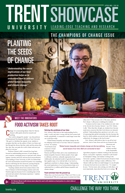This article is also available in Showcase magazine, featuring leading-edge teaching and research at Trent.
“Trent University has been conducting archaeological research in the Maya lowlands, especially Belize, since the 1970s,” reports Dr. Paul Healy, professor of Anthropology and Archaeology. “We’ve offered students truly rare opportunities almost annually to participate in Maya research at 1000 year-old sites such as Pacbitun, Caledonia, Caracol, Cahal Pech, and for the past 15 years, at Minanha, under the direction of Dr. Gyles Iannone.”
We have several professors [Drs. Haines, Iannone, and Healy] who are each conducting research involving Trent students at different locales in Belize. It's almost unique in the world to have this faculty strength, and it means that Trent is not only exceptional for the breadth and depth of its research expertise in Maya archaeology in Canada, but on an international level as well.”
“It’s an experience that you can’t put a value on,” says undergraduate student Amanda Sinclair. Ms. Sinclair was the first Trent student from the Oshawa campus to join the student team led by Dr. Helen Haines at the site of Ka’Kabish, Belize. For Ms. Sinclair, the hands-on experience is essential.
“You start from the beginning,” she explains. “You learn the art of finding dig sites, of laying your grid, of organizing your materials. It sounds simple enough, but until you actually do it, you don’t have that experience.”
With such a wealth of experience and teaching history, program leaders ensure that students walk away with the knowledge needed to make sure every dig is done correctly.
Most recently, at the site of Ka’Kabish, Belize, Professor Haines team made the exciting discovery of an Olmec Jade Spoon, the only one yet to be found in a secure archaeological context.
Prof. Haines explains that, “previous discussions on the pieces theorized that this type of object dated to the Middle Formative period (ca. BC 800-600), but as they all lacked context this couldn't be proven until now. Because our spoon was found in a secure context, it means that we can confirm the dating of these pieces,” she asserts.
“Moreover,” continues Prof. Haines, “as it was found with the remnants of a marine shell bead necklace we can also show that it was likely worn as a pendant … Both the jade and the necklace would have been imported into the area as neither materials are local.
The piece was found in a bedrock deposit along with 16 other pieces of jade. The entire deposit was identified with a small, triangular stone marker that was placed in the floor above the grave. I believe that this was a person of prominence who likely helped found the creation of the community. The offerings show that not only was the person important but that status distinctions were emerging during this early period.”
“The Olmec are seen as the mother culture of Mesoamerican civilization,” explains Joshua Lockett, a University of Toronto upper-year student who joined Trent students on the dig to gain field experience, and who found the jade spoon. “The fact that this spoon was found in a Maya area makes it particularly noteworthy. It could, in fact, throw a wrench in the existing theories of how these cultures interacted and worked.”
“Finding the spoon was amazing,” he explains. “But really, the whole experience is amazing. What you have is an incredible educational opportunity in a setting that inspires, amidst a culture that is truly unique. It is a truly immersive way to learn – and you cannot help but gain so much from taking part in it.”
“It made me seriously consider coming to Trent to do a Master’s degree,” he notes. “Working with Trent professors such as Helen Haines, director of the Ka’Kabish Archaeological Research Project, and alongside really passionate instructors and students has rubbed off on me. It is inspiring.”
“I don’t think you get a true idea of what archeology is about until you get into the field,” says Kendall Hill, a Trent University field supervisor and Anthropology M.A. candidate. “You have to get your hands dirty. It is one thing to learn theory from a book or lecture – it is truly another to be at a site and view the reality of how data is collected, as well as the unique challenges of each different dig.”
Speaking of his approach to teaching and involving his students in archaeological research, Prof. Healy asserts that, “students learn how research is done through participation and observation. In our case, through fieldwork (mapping, excavation, lab analysis, and report writing). I have had grad students and undergraduates participate on my own research in Belize resulting in them being co-authors with me on peer-reviewed journal publications in archaeology. Many of these students went on to advanced (doctoral) studies and are now working as professionals in the field, in museums, universities, and at research centers.”
Posted on Tuesday, November 20, 2012.


































